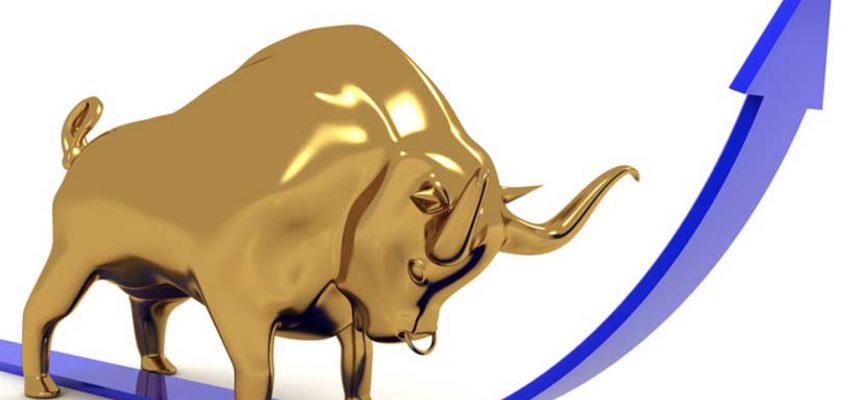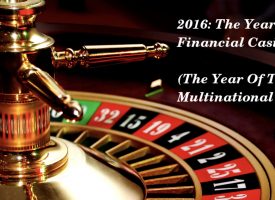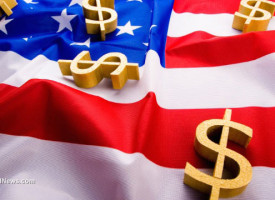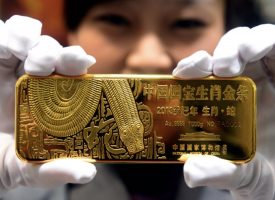Ray Dalio’s estimated net worth is $18.4 billion and he is the found of the world’s biggest hedge fund, Bridgewater Associates, which manages $160 billion. Below are portions of his fantastic piece that ignited the gold market today.
“I believe that it would be both risk-reducing and return-enhancing to consider adding gold to one’s portfolio.” — Ray Dalio
Portions of Ray Dalio’s fantastic piece that ignited gold today
July 17 (King World News) – Ray Dalio: One of my investment principles is: Identify the paradigm you’re in, examine if and how it is unsustainable, and visualize how the paradigm shift will transpire when that which is unsustainable stops.
Over my roughly 50 years of being a global macro investor, I have observed there to be relatively long of periods (about 10 years) in which the markets and market relationships operate in a certain way (which I call “paradigms”) that most people adapt to and eventually extrapolate so they become overdone, which leads to shifts to new paradigms in which the markets operate more opposite than similar to how they operated during the prior paradigm. Identifying and tactically navigating these paradigm shifts well (which we try to do via our Pure Alpha moves) and/or structuring one’s portfolio so that one is largely immune to them (which we try to do via our All Weather portfolios) is critical to one’s success as an investor.
Below, I have summarized the picture of the dynamics for each decade with a very brief description and with a few tables that show asset class returns, interest rates, and economic activity for each decade over the last nine. Through these tables, you can get a feel of the dynamics for each decade, which I then address in more detail and show the market movements in the appendix to this report.
1920s = “Roaring”: From Boom to Bursting Bubble. It started with a recession and the markets discounting negative growth as stock yields were significantly above bond yields, yet there was fast positive growth funded by an acceleration in debt during the decade, so stocks did extremely well.

By the end of the decade, the markets discounted fast growth and ended with a classic bubble (i.e., with debt-financed purchases of stocks and other assets at high prices) that burst in 1929, the last year of the decade.
1930s = Depression. This decade was for the most part the opposite of the 1920s. It started with the bursting reactions to high levels of indebtedness and the markets discounting relatively high growth rates. This debt crisis and plunge in economic activity led to economic depression, which led to aggressive easing by the Fed that consisted of breaking the link to gold, interest rates hitting 0%, the printing of a lot of money, and the devaluing of the dollar, which was accompanied by rises in gold prices, stock prices, and commodity prices from 1932 to 1937. Because the monetary policy caused asset prices to rise and because compensation didn’t keep up, the wealth gap widened, a conflict between socialists and capitalists emerged, and there was the rise of populism and nationalism globally. In 1937, the Fed and fiscal policies were tightened a bit and the stock market and economy plunged. Simultaneously, the geopolitical conflicts between the emerging Axis countries of Germany, Italy, and Japan and the established Allied countries of the UK, France, and China intensified, which eventually led to all-out war in Europe in 1939 and the US beginning a war in Asia in 1941. For the decade as a whole, stocks performed badly, and a debt crisis occurred early, which was largely handled via defaults, guarantees, and monetization of debts along with a lot of fiscal stimulation. For a detailed account of this period, see pages 49-95 in Part Two of Principles for Navigating Big Debt Crises.
1940s = War and Post-War. The economy and markets were classically war-driven. Governments around the world both borrowed heavily and printed significant amounts of money, stimulating both private-sector employment in support of the war effort and military employment. While production was strong, much of what was produced was used and destroyed in the war, so classic measures of growth and unemployment are misleading. Still, this war-effort production pulled the US out of the post-Great Depression slump. Monetary policy was kept very easy to accommodate the borrowing and the paying back of debts in the post-war period.

Specifically, monetary policy remained stimulative, with interest rates held down and fiscal policy liberally producing large budget deficits during the war and then after the war to promote reconstruction abroad (the Marshall Plan). As a result, stocks, bonds, and commodities all rallied over the period, with commodities rallying the most early in the war, and stocks rallying the most later in the war (when an Allied victory looked to be more likely) and then at the conclusion of the war. The pictures of what happened in other countries, especially those that lost the war, were radically different and are worthy of description at another time. After the war, the United States was the preeminent power and the dollar was the world’s reserve currency linked to gold, with other currencies linked to the dollar. This period is an excellent period for exemplifying 1) the power and mechanics of central banks to hold interest rates down with large fiscal deficits and 2) market action during war periods.
1950s = Post-War Recovery. In the 1950s, after two decades of depression and war, most individuals were financially conservative, favoring security over risk-taking. The markets reflected this by de facto pricing in negative levels of earnings growth with very high risk premia (e.g., S&P 500 dividend yields in 1950 were 6.8%, more than 3 times the 10-year bond yield of 1.9%, and earning yields were nearly 14%). What happened in the ‘50s was exactly the opposite of what was discounted. The post-war recovery was strong (averaging 4% real growth over the decade), in part through continued stimulative policy/low rates. As a result, stocks did great. Since the government wasn’t running large deficits, government debt burdens (government debt as a percent of incomes) fell, while private debt levels were in line with income growth, so debt growth was in line with income growth. The decade ended in a financially healthy position, with prices discounting relatively modest growth and low inflation. The 1950s and the 1960s were also a period in which middle-class workers were in high demand and prospered.
1960s = From Boom to Monetary Bust. The first half of the decade was an increasingly debt-financed boom that led to balance of payments problems in the second half, which led to the big paradigm shift of ending the Bretton Woods monetary system. In the first half, the markets started off discounting slow growth, but there was fast growth so stocks did well until 1966. Then most everyone looked back on the past 15 years of great stock market returns and was very bullish. However, because debt and economic growth were too fast and inflation was rising, the Fed’s monetary policy was tightened (e.g., the yield curve inverted for the first time since 1929). That produced the real (i.e., inflation-adjusted) peak in the stock market that wasn’t broken for 20 years. In the second half of the 1960s, debt grew faster than incomes and inflation started to rise with a “growth recession,” and then a real recession came at the end of the decade. Near the end of the ‘60s, the US balance of payments problem became more clearly manifest in gold reserves being drawn down, so it became clear that the Fed would have to choose between two bad alternatives—i.e., a) too tight a monetary policy that would lead to too weak an economy or b) too much domestic stimulation to keep the dollar up and inflation down. That led to the big paradigm shift of abandoning the monetary system and ushering in the 1970s decade of stagflation, which was more opposite than similar to the 1960s decade.
1970s = Low Growth and High Inflation (i.e., Stagflation). At the beginning of the decade, there was a high level of indebtedness, a balance of payments problem, and a strained gold standard that was abandoned in 1971. As a result, the promise to convert money for gold was broken, money was “printed” to ease debt burdens, the dollar was devalued to reduce the external deficits, growth was slow and inflation accelerated, and inflation-hedge assets did great while stocks and bonds did badly during the decade.

There were two big waves up in inflation, inflation expectations, and interest rates, with the first from 1970 to 1973 and the second and bigger one from 1977 to 1980-81. At the end of the decade, the markets discounted very high inflation and low growth, which was just about the opposite of what was discounted at the end of the prior decade. Paul Volcker was appointed in August 1979. That set the stage for the coming 1980s decade, which was pretty much the opposite of the 1970s decade.
1980s = High Growth and Falling Inflation (i.e., Disinflation). The decade started with the markets discounting high inflation and slow growth, yet the decade was characterized by falling inflation and fast growth, so inflation-hedge assets did terribly and stocks and bonds did great. The paradigm shift occurred at the beginning of the decade when the tight money conditions that Paul Volcker imposed triggered a deflationary pressure, a big economic contraction, and a debt crisis in which emerging markets were unable to service their debt obligations to American banks. This was managed well, so banks were provided with adequate liquidity and debts weren’t written down in a way that unacceptably damaged bank capital. However, it created a shortage of dollars and capital flows that led the dollar to rise, and it created disinflationary pressures that allowed interest rates to decline while growth was strong, which was great for stock and bond prices. As a result, this was a great period for disinflationary growth and high investment returns for stocks and bonds.
1990s = “Roaring”: From Bust to Bursting Bubble. This decade started off with a recession, the first Gulf War, and the easing of monetary policy and relatively fast debt-financed growth and rising stock prices; it ended with a “tech/dot-com” bubble (i.e., debt-financed purchases of “tech” stocks and other financial assets at high prices) that looked quite like the Nifty Fifty bubble of the late 1960s. That dot-com bubble burst just after the end of the decade, at the same time there were the 9/11 attacks, which were followed by very costly wars in Iraq and Afghanistan.
2000-10 = “Roaring”: From Boom to Bursting Bubble. This decade was the most like the 1920s, with a big debt bubble leading up to the 2008-09 debt/economic bust that was analogous to the 1929-32 debt bust. In both cases, these drove interest rates to 0% and led to central banks printing a lot of money and buying financial assets. The paradigm shift happened in 2008-09, when quantitative easing began as interest rates were held at or near 0%.

The decade started with very high discounted growth (e.g., expensive stocks) during the dot-com bubble and was followed by the lowest real growth rate of any of these nine decades (1.8%), which was close to that of the 1930s. As a result, stocks had the worst return of any other decade since the 1930s. In this decade, as in the 1930s, interest rates went to 0%, the Fed printed a lot of money as a way of easing with interest rates at 0%, the dollar declined, and gold and
T-bonds were the best investments. At the end of the decade, a very high level of indebtedness remained, but the markets were discounting slow growth.
2010-Now = Reflation. The shift to the new paradigm, which was also the bottom in the markets and the economy, came in late 2008/early 2009 when risk premiums were extremely high, interest rates hit 0%, and central banks began aggressive quantitative easings (“printing money” and buying financial assets). Investors took the money they got from selling their financial assets to central banks and bought other financial assets, which pushed up financial asset prices and pushed down risk premiums and all asset classes’ expected returns. As in the 1932-37 period, that caused financial asset prices to rise a lot, which benefited those with financial assets relative to those without them, which widened the wealth gap. At the same time, technological automation and businesses globalizing production to lower-cost countries shifted wages, particularly for those in the middle- and lower-income groups, while more of the income gains over the decade went to companies and high-income earners. Growth was slow, and inflation remained low. Equities rallied consistently, driven by continued falling discount rates (e.g., from central bank stimulus), high profit margins (in part from automation keeping wage growth down), and, more recently, from tax cuts. Meanwhile, the growing wealth and income gaps helped drive a global increase in populism. Now, asset prices are relatively high, growth is priced to remain moderately strong, and inflation is priced to remain low.
“…those that will most likely do best will be those that do well when the value of money is being depreciated and domestic and international conflicts are significant, such as gold.” — Ray Dalio
The Coming Paradigm Shift
There’s a saying in the markets that “he who lives by the crystal ball is destined to eat ground glass.” While I’m not sure exactly when or how the paradigm shift will occur, I will share my thoughts about it. I think that it is highly likely that sometime in the next few years, 1) central banks will run out of stimulant to boost the markets and the economy when the economy is weak, and 2) there will be an enormous amount of debt and non-debt liabilities (e.g., pension and healthcare) that will increasingly be coming due and won’t be able to be funded with assets. Said differently, I think that the paradigm that we are in will most likely end when a) real interest rate returns are pushed so low that investors holding the debt won’t want to hold it and will start to move to something they think is better and b) simultaneously, the large need for money to fund liabilities will contribute to the “big squeeze.” At that point, there won’t be enough money to meet the needs for it, so there will have to be some combination of large deficits that are monetized, currency depreciations, and large tax increases, and these circumstances will likely increase the conflicts between the capitalist haves and the socialist have-nots. Most likely, during this time, holders of debt will receive very low or negative nominal and real returns in currencies that are weakening, which will de facto be a wealth tax.
Right now, approximately 13 trillion dollars’ worth of investors’ money is held in zero or below-zero interest-rate-earning debt. That means that these investments are worthless for producing income (unless they are funded by liabilities that have even more negative interest rates). So these investments can at best be considered safe places to hold principal until they’re not safe because they offer terrible real returns (which is probable) or because rates rise and their prices go down (which we doubt central bankers will allow).
Thus far, investors have been happy about the rate/return decline because investors pay more attention to the price gains that result from falling interest rates than the falling future rates of return. The diagram below helps demonstrate that. When interest rates go down (right side of the diagram), that causes the present value of assets to rise (left side of the diagram), which gives the illusion that investments are providing good returns, when in reality the returns are just future returns being pulled forward by the “present value effect.” As a result future returns will be lower.

That will end when interest rates reach their lower limits (slightly below 0%), when the prospective returns for risky assets are pushed down to near the expected return for cash, and when the demand for money to pay for debt, pension, and healthcare liabilities increases. While there is still a little room left for stimulation to produce a bit more of this present value effect and a bit more of shrinking risk premiums, there’s not much.
At the same time, the liabilities will be coming due, so it’s unlikely that there will be enough money pushed into the system to meet those obligations. Then it is likely that there will be a battle over 1) how much of those promises won’t be kept (which will make those who are owed them angry), 2) how much they will be met with higher taxes (which will make the rich poorer, which will make them angry), and 3) how much they will be met via much bigger deficits that will be monetized (which will depreciate the value of money and depreciate the real returns of investments, which will hurt those with investments, especially those holding debt).
The charts below show the wave of liabilities that is coming at us in the US.
*Note: Medicare, Social Security, and other government programs represent the present value of estimates of future outlays from the Congressional Budget Office. Of course, some of the IOUs have assets or cash flows partially backing them (like tax revenue covering some Social Security outlays). 10-year forward projections are based on government projections of public debt and social welfare payments.

*Note: Medicare, Social Security, and other government programs represent the present value of estimates of future outlays from the Congressional Budget Office. Of course, some of the IOUs have assets or cash flows partially backing them (like tax revenue covering some Social Security outlays). 10-year forward projections are based on government projections of public debt and social welfare payments.
History has shown us and logic tells us that there is no limit to the ability of central banks to hold nominal and real interest rates down via their purchases by flooding the world with more money, and that it is the creditor who suffers from the low return.
Said differently:
The enormous amounts of money in no- and low-returning investments won’t be nearly enough to fund the liabilities, even though the pile looks like a lot. That is because they don’t provide adequate income. In fact, most of them won’t provide any income, so they are worthless for that purpose. They just provide a “safe” place to store principal. As a result, to finance their expenditures, owners of them will have to sell off principal, which will diminish the amount of principal that they have left, so that they a) will need progressively higher and higher returns on the dwindling amounts (which they have no prospect of getting) or b) they will have to accelerate their eating away at principal until the money runs out.
That will happen at the same time that there will be greater internal conflicts (mostly between socialists and capitalists) about how to divide the pie and greater external conflicts (mostly between countries about how to divide both the global economic pie and global influence). In such a world, storing one’s money in cash and bonds will no longer be safe. Bonds are a claim on money and governments are likely to continue printing money to pay their debts with devalued money. That’s the easiest and least controversial way to reduce the debt burdens and without raising taxes. My guess is that bonds will provide bad real and nominal returns for those who hold them, but not lead to significant price declines and higher interest rates because I think that it is most likely that central banks will buy more of them to hold interest rates down and keep prices up. In other words, I suspect that the new paradigm will be characterized by large debt monetizations that will be most similar to those that occurred in the 1940s war years.
So, the big question worth pondering at this time is which investments will perform well in a reflationary environment accompanied by large liabilities coming due and with significant internal conflict between capitalists and socialists, as well as external conflicts. It is also a good time to ask what will be the next-best currency or storehold of wealth to have when most reserve currency central bankers want to devalue their currencies in a fiat currency system.
Most people now believe the best “risky investments” will continue to be equity and equity-like investments, such as leveraged private equity, leveraged real estate, and venture capital, and this is especially true when central banks are reflating. As a result, the world is leveraged long, holding assets that have low real and nominal expected returns that are also providing historically low returns relative to cash returns (because of the enormous amount of money that has been pumped into the hands of investors by central banks and because of other economic forces that are making companies flush with cash). I think these are unlikely to be good real returning investments and that those that will most likely do best will be those that do well when the value of money is being depreciated and domestic and international conflicts are significant, such as gold. Additionally, for reasons I will explain in the near future, most investors are underweighted in such assets, meaning that if they just wanted to have a better balanced portfolio to reduce risk, they would have more of this sort of asset. For this reason, I believe that it would be both risk-reducing and return-enhancing to consider adding gold to one’s portfolio. I will soon send out an explanation of why I believe that gold is an effective portfolio diversifier.
Major Silver Breakout Unfolding
READ THIS NEXT! Major Silver Breakout Unfolding…Similar Breakouts Saw Silver Soar A Staggering 66% To 975% CLICK HERE TO READ
AUDIO RELEASED
King World News note: There was a short delay in the release of the latest audio interview with the man who helps to oversee more than $200 billion and you can now listen to it by CLICKING HERE OR ON THE IMAGE BELOW.
More articles to follow…
In the meantime, other important releases…
CONTRARIAN ALERT: Only 1% Of People Think This Bullish Gold Catalyst Will Trigger CLICK HERE TO READ
Is The Price Of Silver About To Skyrocket? Plus “All Hell Is Going To Break Loose” CLICK HERE TO READ
Silver Is Finally Acting Better, Plus Breaking Down Gold’s Breakout CLICK HERE TO READ
Silver Is Finally Acting Better, Plus Breaking Down Gold’s Breakout CLICK HERE TO READ
© 2019 by King World News®. All Rights Reserved. This material may not be published, broadcast, rewritten, or redistributed. However, linking directly to the articles is permitted and encouraged








